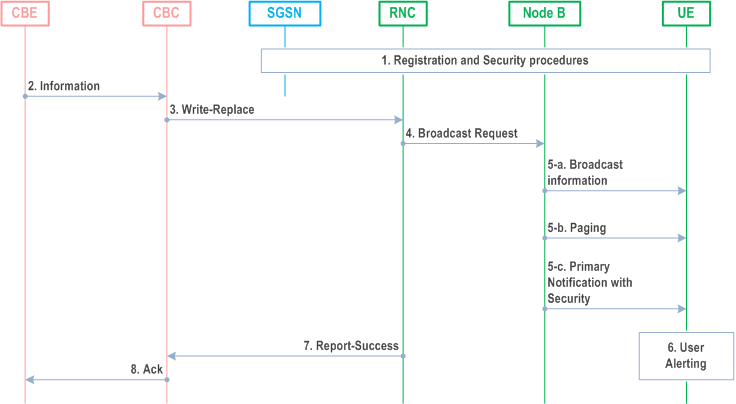Content for TS 23.041 Word version: 18.5.0
1…
2
3…
4…
6…
9…
9.1.3.3
9.1.3.4…
9.1.3.5…
9.1.4…
9.2…
9.2.10…
9.2.21…
9.3…
9.3.20…
9.3.40…
9.4…
9.4.2…
9.5
9A…
10…
B…
9.1.3.3 Warning Message Delivery Procedure in UMTS |R8| p. 25
When a warning message is sent in UTRAN, the following message flow applies. In this case, the paging message with a new emergency indication can invoke mobile terminals to start receiving CBS messages without MMI. Mobile stations invoked to start receiving CBS messages this way may stop receiving CBS messages (without MMI) after a period of time, which should not be less than 30 minutes in case DRX-Level-2 is used, and 2 minutes in case DRX-Level-1 is used.

Step 1.
Network registration and security (e.g. mutual authentication) procedures are performed.
Step 2.
CBE (e.g. Information Source such as PSAP or Regulator) sends emergency information ("warning type", "warning message", "impacted area", and "time period") to the CBC. The CBC shall authenticate this request. The "warning type" takes one of the following values: earthquake, tsunami, earthquake and tsunami, test, or other.
Step 3.
Using the "impacted area information", the CBC identifies which RNCs need to be contacted and constructs the "Service Area ID list" for the cells in which the information is to be broadcast.
The CBC shall send a WRITE-REPLACE message to all the identified RNCs. The message shall include an "emergency indication" to differentiate it from normal Cell Broadcast information, as well as the "Service Area ID list", "warning type", "warning message".
The CBC shall not include the "digital signature" or "timestamp" information.
Step 4.
The RNCs use the "Service Area ID list" information to identify which Node Bs they need to reach, and then, they relay information to them using the appropriate Iub interface message.
Step 5.
The Node B receives the Iub message containing the emergency indication. As parallel actions, the RNC/Node B:
Step 6.
- shall start to broadcast the "warning message". This is broadcast by using a Cell Broadcast channel and modified System Information messages. This broadcast information is repeated continuously by the Node B for the "time period" requested by the CBE.
- shall use paging messages in every paging group to alert idle mode mobiles to receive the broadcast warning message. Typically these paging messages are repeated in all paging groups for several DRX periods. The paging message contains the "ETWS indication" based on the "warning type" information. When the "warning type" is set to 'other', all of the warning information is included in the broadcast "warning message".
- may send the "ETWS indication" in other messages (System Information Change Indication or ETWS Primary Notification With Security) in order to reach mobiles in connected mode. Inclusion of "ETWS indication" is the same as that of the paging message mentioned above.
If the UE is configured to accept warnings on that PLMN (see TS 31.102) the UE alerts the user immediately, using "warning type" value upon the reception of the "ETWS Indication".
Upon the reception of the"ETWS Indication", the UE activates the reception of the broadcast messages containing the "warning message" as the secondary notification. The UE indicates the contents of the "warning message" to the user.
The UE shall perform duplication detection of the received message as specified in clause 8.2.
The UE shall ignore the values of "digital signature" and "timestamp" if received.
Step 7.
The RNC node sends a BMC REPORT-SUCCESS to the CBC in response to Write-Replace.
Step 8.
CBC sends acknowledgement message to CBE.